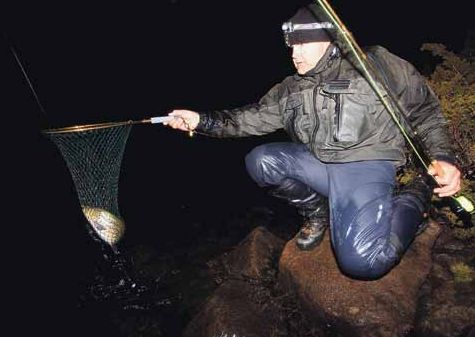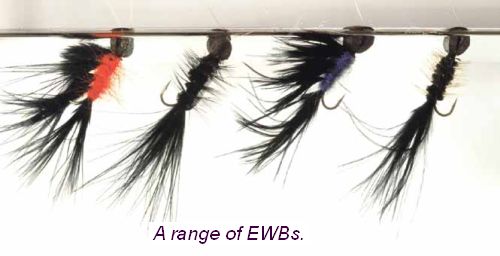 Presented from Issue 99
Presented from Issue 99
The Western Lakes can be a tough place to catch a fish, especially if you’re limiting yourself to sight fishing only. There are many influencing factors that can contribute to seeing very few fish during the day. We see fish in the shallows because there is often some kind of food present that brings them in close to shore. So if there is no food, they really have no reason to leave the security and food rich environment of the deeper water. During low water levels and high water temperatures in late summer, trout will often shelter under rocks during the heat of the day and only venture out late in the evening and into the night to feed. These are the days when you can walk all day and only seen one or two fish.
Miss your chance on these and you can easily blank out for the day. Most of us get a few blank days in a season; it’s part of fishing. Some days they are just feeding or holding up out in the weed beds and resting under rocks until the nightfall for a more productive and energy conserving time to feed.
For those of us who have enough energy to fish on after a tough day, the night session can be our saving grace, offering a new and exciting option to catch at least one fish before calling it a night.
Where to find them at night
Be it night or day, there are typically two ways that trout will feed. One is to waiting in ambush and allows the food to come to them and the other is to actively search and hunt down food.
Fish lying in ambush will often hold motionless up against the shoreline where they have a chance to cross paths with small baitfish or frogs that are using the sheltered shoreline to migrate around the lake. It’s also important to remember that these fish are not only found on those nice sheltered shores but also along the shorelines that have the waves pounding onto them. Just like during the daytime, food in the way of stick caddis and snails are dislodged and pushed up against these shores. So these trout along the shores have the best of both worlds, snails, stick caddis and anything else edible that is washed their way, plus the chance to seize a larger meal, like a small baitfish or frog, at the same time.
The fish that are on the move can often be seen swimming very slowly inching their way along the shoreline or out along the weed beds in search of food. Fishing from a point is a good place to intercept these fish on the move during the night, as they also offer fish a great ambush point.
Night tactics
Fly fishing by night might sound difficult if you start to worry about having to manage all that fly line and those hidden obstacles that are in the water and on land. The truth is, you really don’t have to cast very far at night to catch a fish in the Western Lakes. The fish are often so close to the shore at night that you could just fish the length of your leader to catch fish.
If you’ve never tried fly fishing night, one of the best times to give it a go is under the light of a full moon when you can actually see what you’re doing. This is also the one time when you can see a fish rise to take a dry fly at night.
As the nights get darker you will learn to fish by feel and sound alone with a heightened sense of anticipation of the next fish loading up your line as it takes your fly.
With the exception of fishing to rising fish under a full moon, most night fishing is done by systematically covering the water just as you would during daylight hours. Fish are still going to be spooked by a fly line landing on top of them in shallow, so it’s a good idea to always start fishing a short line in close, before you start lengthening the cast.
Retrieving a fly at night is usually done using a slow figure eight hand retrieve, or by slowly stripping in line. By retaining the line in your hand as it’s gathered in, you will keep it away from the rocks and alpine vegetation, that will almost certainly entangle your line if was merely dropped at your feet.
Leaders are best kept shorter than a rod length, so you know when the fly is in your hand, there is always going to be some fly line beyond the rod tip to initiate the cast.
Light tippet material is really only required if you want the challenge of capturing a fish on extremely light line. I fish with anything upward of six pounds, depending on the size of fish that could be encountered. Flies for night fishing need to be practical and easy to use. In deep water you can get away with using all kinds of wet flies, from fur flies, down to nymphs, without snagging up on the bottom and losing flies. However, many of the Western Lakes are quite shallow and the use of a semi-buoyant fly, or even a unsinkable dry fly, is a much more practical way of fishing these lakes at night. Flies that come to mind are the Cork Fly, Cubits Mudeye, dear hair patterns and all of the foam and rubber leg flies such as the Chernobyl Ant, foam sandwich flies and Peter Broomhall’s Bruisers Bug.
My personal all year round favorite is a semi- buoyant fly like my EWB (Emerging Woolly Bugger) or any of its hybrids like the Marabou EWB and the Zonker EBW. These variations are all affectionately referred to, as “oobs” by my fishing mates, who use them. They all have the same foam head to float them at the surface and a few turns of copper or lead wire at the bend of the hook during the tying stage, to pull the back end of the fly down beneath the surface, to resemble a baitfish or frog. They can also be tied in a “Bend Back” style on a long shank straight eye hook to fish them point up in amongst thick weeds.
The biggest advantage of this fly and flies like it, is that it can be fished at any depth without fouling the bottom. This also allows it to be fished with a long pause to allow the slightest wave action to give life to the marabou or fur to suggest something struggling and vulnerable at the surface that is going to make an easy meal, that is just to good to pass up.
Saved by the night session After a long day and far too many kilometres, I was returning to our base camp having missing the one and only fish I saw the entire day. On this particular trip, I was fishing with Mark Woodhall and Simon-Peter Hedditch. It was tough fishing, with very few fish sighted. Simon had managed one fish and Mark had landed two for the day. The day was less than perfect, with wind and periods of rain and now with the fading light, a thunderstorm was starting to build. I was still keen to do some night fishing despite the weather. The full moon had just risen above the horizon, but was soon covered by the black storm clouds. I had already briefly raised the subject of fly fishing at night to both Mark and Simon, but they were not about to be caught up in my sudden urge to fish into the night after such a long day and were happy to just call it a day and crawl into their sleeping bags. I couldn’t really blame them as it was starting to rain again and the wind was howling. Not to be deterred by the weather, I had an itch that just had to be scratched, it had been a while since I had done any night fishing out in the Western Lakes and I was determined to make the most of our two night stay. I made my way around the Lake until I found a narrow point, jutting out into the lake between two shallow bays. On one side of the point the wind and waves crashed onto its shore, while the other side of the point was sheltered from the wind and was flat calm.

I fished the size six EWB on a short line into the wind on the rough shore, slowly working my way around the point to the calm water that was partially sheltered by the point. Every now and then the moon would shine through the clouds allowing me to see the wake of the EWB as I gave it a slow strip before allowing it to sit motionless once again. By now, I was casting about six metres of fly line beyond the rod tip to work the fly closer to some large rocks that I could see in the moon light. After the first strip I let the fly sit for three or four seconds before I gave it another slow strip followed by another pause. The fly had only sat there for a couple of seconds, when I saw a fish take it from the surface. I paused and lifted the rod to set the hook into the first fish of the night. I immediately switched on my headlamp to see where the fish was heading and to steer it around any obstructions during the fight. It didn’t take long to have the fish thrashing around in my net. As I had no need to keep a fish back here, it was quickly released. The next fish took the fly in exactly the same way.
I had been fishing for about an hour and was keen to fish on, but that thought was short lived when the next flash of lightening and a load clap of thunder was just too close for comfort. Besides a lightning storm is really no place to be waving around a graphite fly rod, so I made a hasty retreat back to my tent just before the rain started to bucket down.
The next day was another tough day to find fish, with only two fish being landed between us. After my efforts of the previous night, Simon and Mark were keen to give this night fishing a go. The night was much more appealing with the full moon shining past the clouds, allowing us to make our way around much of the lake without the need of our headlamps. We were all fishing with EWBs and it was Simon who caught the first two fish of the night. I drop one after a very short fight and then hooked and landed one while fishing into the wind along another rocky point. Mark was just happy to see how effective night fishing can be. He also commented on how his early nights in his tent would now be a thing of the past with this alternative way of fishing the Western Lakes.
Craig Rist

